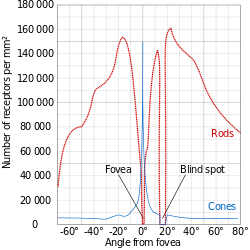Blind spot (vision)
A blind spot, scotoma, is an obscuration of the visual field. A particular blind spot known as the physiological blind spot, "blind point", or punctum caecum in medical literature, is the place in the visual field that corresponds to the lack of light-detecting photoreceptor cells on the optic disc of the retina where the optic nerve passes through the optic disc.[2] Because there are no cells to detect light on the optic disc, the corresponding part of the field of vision is invisible. Some process in our brains interpolates the blind spot based on surrounding detail and information from the other eye, so we do not normally perceive the blind spot.
Although all vertebrates have this blind spot, cephalopod eyes, which are only superficially similar, do not. In them, the optic nerve approaches the receptors from behind, so it does not create a break in the retina.
The first documented observation of the phenomenon was in the 1660s by Edme Mariotte in France. At the time it was generally thought that the point at which the optic nerve entered the eye should actually be the most sensitive portion of the retina; however, Mariotte's discovery disproved this theory.
The blind spot is located about 12–15° temporally and 1.5° below the horizontal and is roughly 7.5° high and 5.5° wide.[3]
Blind spot test
| Demonstration of the blind spot | ||||
|---|---|---|---|---|
| R | L | |||
| Instructions: Close one eye and focus the other on the appropriate letter (R for right or L for left). Place your eye a distance from the screen approximately equal to 3× the distance between the R and the L. Move your eye towards or away from the screen until you notice the other letter disappear. For example, close your right eye, look at the "L" with your left eye, and the "R" will disappear. | ||||
See also
References
- ↑ Brian A. Wandell (1 January 1995). Foundations of Vision. Sinauer Associates. ISBN 978-0-87893-853-7.
- ↑ Gregory, R., & Cavanagh, P. (2011). "The Blind Spot". Scholarpedia. Retrieved on 2011-05-21.
- ↑ MIL-STD-1472F, Military Standard, Human Engineering, Design Criteria For Military Systems, Equipment, And Facilities (23 Aug 1999) PDF
External links
- "Amsler Grid" Test from Ossibus Software
- Blind spots
- Blind spot test
- Blind spot map tool

